Goats are well-known as a reliable source of meat and milk.
In fact, they are essential livestock and farm animals in some countries due to their environmental adaptability and economical purposes.
There are different breeds of domesticated goats with unique personalities, physical traits, and even sizes and colors.
And some would agree that black goats do have their own charm and distinctive qualities. If you are one of the people who love black animals, especially goats, these are 15 black goat breeds that you should know:
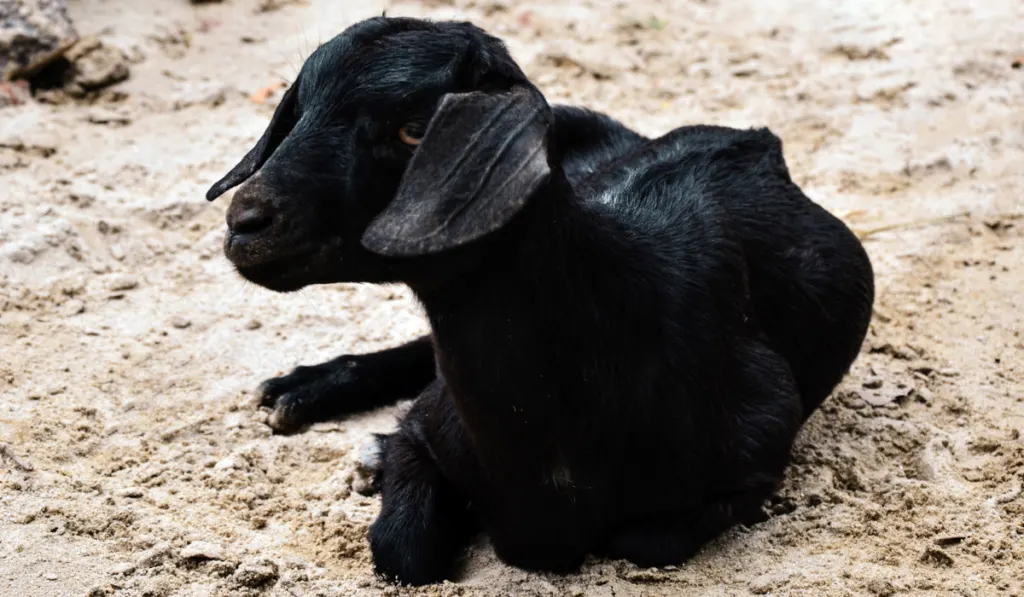
Table of Contents
1. Black Bengal Goat
Black Bengal goats are largely found throughout Bangladesh, Bihar, West Bengal, Odisha, and Orissa regions of northeastern Indian.
In fact, more than 90 percent of goats in Bangladesh are Black Bengals. This breed possesses a small but tight body.
Their legs and horns are also small in relation to their body structure. Male goats weigh between 55 and 66 pounds (25-30 kg) while females weigh between 33 and 44 pounds (15-20 kg).
They are mostly seen in black but in some cases, brown, white, and gray colors could also be found on them.
Black Bengal goats are docile, easy-going, and love to interact with people. They are bred mostly for their meat.
Aside from being resistant to many diseases, they also don’t require much attention because they thrive in harsh environments and dry climates.
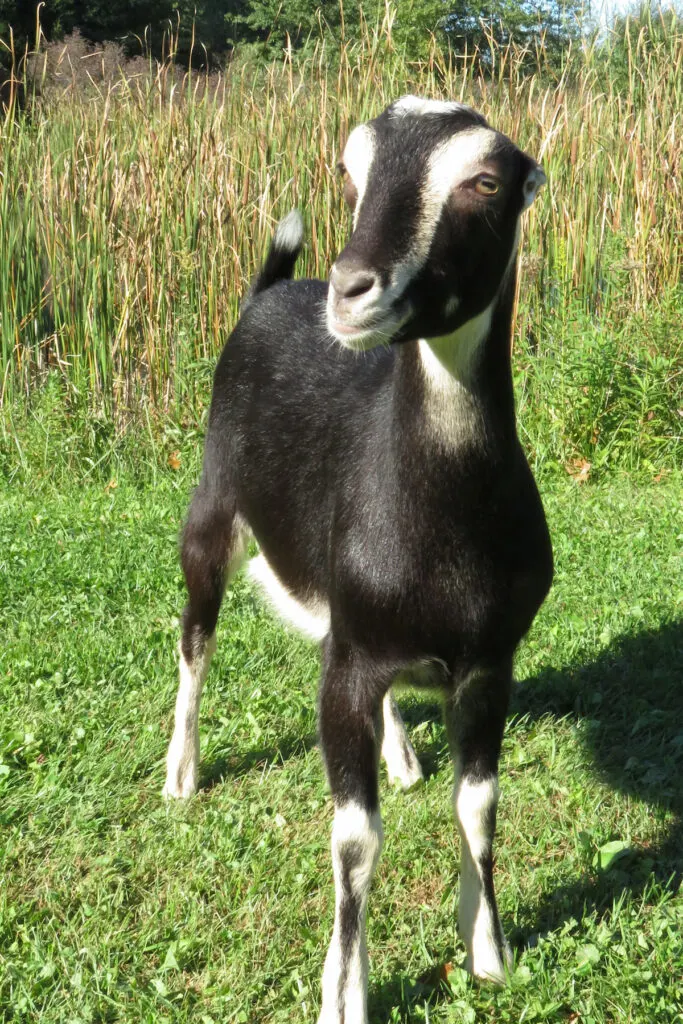
2. LaMancha Goat
This goat breed is native to Oregon. A woman named Eula F. Frey was the first person to develop this breed from a specific type of short-eared goat.
In 1958, LaMancha goats were recognized by the American Dairy Goat Association as a breed.
LaMancha goats possess a straight face and flossy short hair. They generally stand between 28 and 30 inches (71-76 cm) and weigh around 130 to 150 pounds (58-68 kg). Their hair colors are mainly black, white, brown, gold, and chestnut.
The LaManchas are unique with their two distinct ear types: the gopher ears (around 1 inch) and the elf ears (around 2 inches).
They are docile and easy to raise for milk production. They can produce up to two gallons of milk per day.
3. Uzbek Black Goat
Like their name, Uzbek black goats originated in Uzbekistan. They were developed as a by-product in the production of a new breed, which is the Soviet Mohair goat.
Uzbek goats possess long wool fibers, except along their spine. In spring, the spine hairs don’t shed, but the wool does.
They are quite similar to Don goats in their productivity, fleece structure, and the physical properties of their wool fibers.
The Uzbeks produce black wool and shed a lot, especially when combed. Depending on their age, they can shed up to 40 percent of their black wool.
In the Namangan region of Uzbekistan, specifically in the state farm of Baisun, it has been estimated that there are about 10,000 Uzbek black goats that are raised for black wool production.
4. Murciano Granadina Goat
The Murciano Granadina goats are native to the semi-arid areas in south Eastern Spain like Almeria, Granada, Murcia, and Alicante. They were introduced to Mexico, Argentina, Venezuela, and Brazil before being exported to other countries like North Africa.
These medium-sized goats possess a well-built, sturdy body, and medium-length ears that erect.
Bucks generally have horns with longer and stronger hair while does have well-shaped udders, with short and thin hair. Their hair comes in solid colors like black, brown, and mahogany.
The Murciano Granadina goats are an extremely hardy breed, resistant to diseases, and able to thrive in a dry environment.
Most of these goats are raised specifically for their milk which is high in protein and fat. But some small farmers also raised this breed for their meat.
5. Anatolian Black Goat
The Anatolian black goats originated in Turkey and were originally raised by small farmers. These small domesticated goats are also known by their other names like Kilgoat, Kara Keci, Turkish Native, Kil-Kei, and Adi Kei. They generally stand between 30 and 40 inches (76-101 cm) and weigh around 150 pounds (68 kg).
The Anatolians possess a small head, long drooping ears, and coarse long hair. Black, brown, light gray, and pied are common colors.
They also have a thick undercoat that insulates their body from cold. Unlike most goats, the Anatolians are a triple-purpose breed, raised for their wool, milk, and meat.
Being an excellent milk producer, a single Anatolian black goat could produce up to 3000 pounds (1361 kg) of milk per year.
This breed is economically viable to many breeders and farmers because they are easy to raise, disease-resistant, and able to strive under harsh climates.
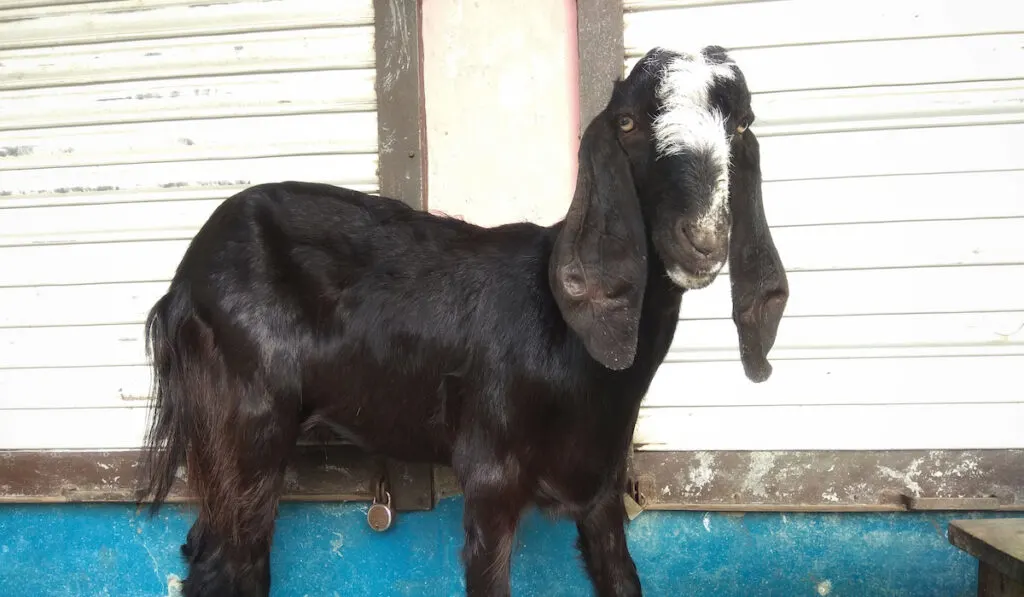
6. Beetal Goat
Beetal goats are native to the region of Punjab in India and Pakistan. Also known as Lahori goats, they are raised mainly for their milk and meat.
These dual-purpose goats stand between 71 and 89 cm (28-35 inches) and weigh around 40 to 60 kg (88-132 pounds).
They have a large body, pendulous ears, and long twisted horns. The Beetals generally come in basic colors like black, red, white, and pied.
They can produce up to 2 kilograms (4 pounds) of milk per day. It is quite easy to raise Beetal goats because they eat almost any edible plants and food.
Plus, they are independent and able to adapt to different climates. Their skins are also tanned into fine leathers like suede, velour, and chamois.
7. Osmanabadi Goat
The Osmanabadi goats received their name from their place of origin, which is the Osmanabad district in the Indian state of Maharashtra.
But they can also be found in the north-eastern districts of Karnataka state. This medium to large-sized goat stands between 72 and 75 cm (28-30 inches) and weighs around 32 to 34 kg (70-74 pounds).
Male goats of this breed are horned with almost 5 percent of female goats born polled. The Osmanabadi goats mainly come in black but some small white spots may be found on their body, ears, and neck. They have medium-sized drooping ears and shiny, short hair coats.
Being a dual-purpose breed, they are mainly raised for milk and meat. Raising this breed is cost-effective because it can thrive in drought conditions and is resistant to many diseases. Plus, their skins are turned into high-quality leathers.
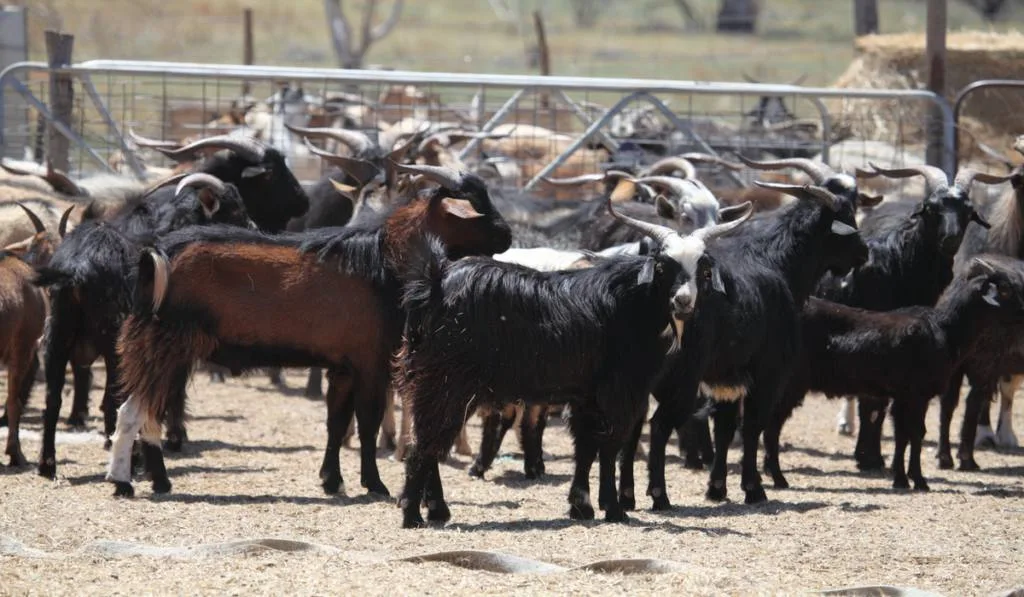
8. Australian Melaan Goat
The Australian Melaan goats were first developed in Australia. They received their name from their color; ‘Mel’ comes from the word‘ melanin’ and the ‘aan’ is from Saanen. Some people also believe that this breed originated from a Saanen buck imported in 1943.
The Australian Melaan goats possess a well-built, strong body with glossy, short black hair.
Being recognized as a breed in 2000, they are one of the popular goat breeds in Australia due to their ability to adapt to changing weather conditions. They are also intelligent, active, and extremely resistant to parasites and diseases.
9. Marwari Goat
These medium-sized goats originated from India. They received their name from their place of origin, which is the Marwar region of Rajasthan.
But they could also be found throughout the Nagaur, Jodhpur, Pali, Jaloner, Bikaner, Barmer, and Jaisalmer districts.
Marwari goats possess long hairs and shaggy coats that mostly come in black. But in some cases, brown and white markings may also be found on their body. They generally stand between 69 and 74 cm (27-29 inches) and weigh around 32 to 42 kg (70-92 pounds).
They have long, drooping ears and both sexes have horns. The only difference is that bucks have longer and stronger horns than females.
Like other dual-purpose goats, Marwari goats are raised mainly for their milk and meat.
Does can produce between 0.5 to 1 kilogram (1-2 pounds) of milk per day. Being a hardy breed, they thrive in harsh and dry climates and are extremely resistant to parasites and diseases.
10. Zhiwulin Black Goat
Zhiwulin black goats are native to the northern Shaanxi region of China. They have a long, black cashmere coat and medium-length, white horns that curve backward. This breed is bred mostly for its meat and cashmere production.
However, they do provide a good amount of milk as well. Zhiwulins are one of the more exotic black goats available but not much information is widely known about them.

11. British Alpine Goat
The British Alpine goats were first developed by the British in the early 1900s. They were produced by crossing native English goats with Alpine goats from Switzerland. In 1958, they arrived in Australia and have been upgraded using Toggenburg and Saanen does.
The British Alpines are tall, medium to large-sized goats with well-set eyes, erect ears, and medium-length horns.
They generally stand between 83 and 95 cm (33-37 inches) and weigh around 77 kg (170 pounds). Their glossy coats are mostly in solid colors like black and brown but some white markings can be found on their face and legs.
This breed is an excellent producer of milk. But they can only live in temperate climates and perform poorly in high humidity areas.
12. Spanish Goat
This breed originated in Spain but was brought to the Caribbean Islands and made its way to Mexico and the United States.
They are known by names like scrub goats, wood goats, brush goats, hill goats, and briar goats. Spanish goats can grow up to 20 inches (51 cm) and weigh around 100 to 250 pounds (68-91 kg).
Their coats mainly come in common colors like black, dark red, white, brown, and gray. They also have a large body, long ears, and backward-curved horns that are quite long.
Being a hardy breed, Spanish goats are extremely resistant to dry climates and harsh environments. They are also disease-resistant and don’t need much attention other than their essential needs.
However, this breed is not suitable for beginners and inexperienced breeders. Spanish goats are typically hard to handle and anxious around people. Other than that, they definitely serve as a good source of milk and meat.
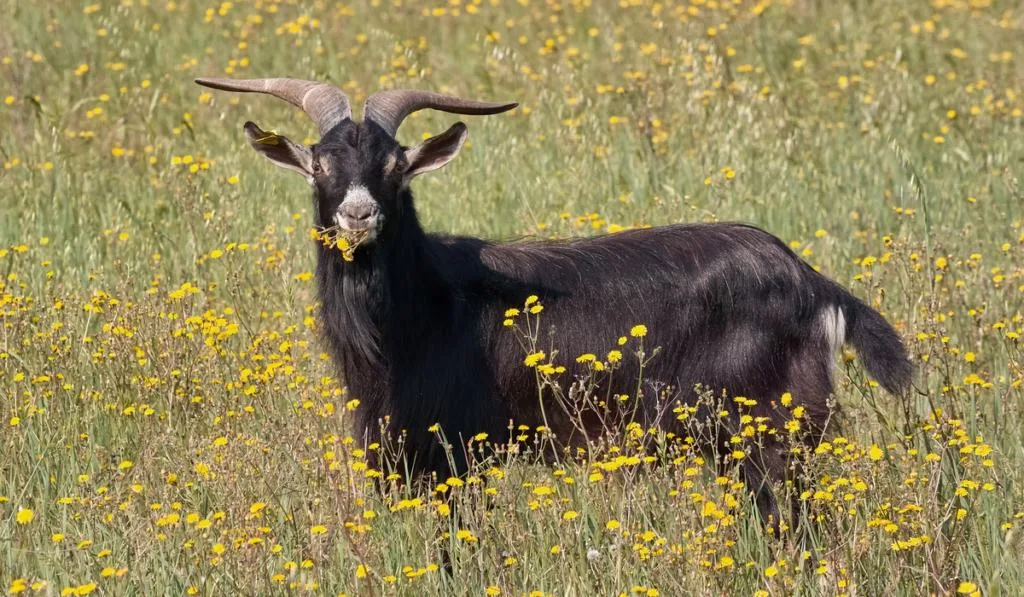
13. Garganica Goat
Garganica goats are an ancient breed native to the Gargano peninsula located in the Puglia region of southern Italy. They derived from the results of crossbreeding between the local breeds of Italy and the exotic breeds of Western Europe.
Also known as the Fulva Lucchese, they are medium-sized goats that possess a sturdy body, short legs, and distinctively large horns. They have a thick coat that comes in base colors like black, brown, and chestnut.
Bucks generally stand around 85 cm (33 inches) and does stand at a height of 75 cm (29 inches). The Garganicas are very hardy and active goats.
They are well-known for their extreme resilience toward harsh environments and climates. Garganicas are raised for their milk and meat.
Their meat is used to produce muscisca, a traditional food of the region. They are listed as an endangered species, with only 773 Garganica goats in the world at the last recording in 2013.
14. Attappady Black Goat
Attappady black goats originated in the Palakkad district of Kerala, India. Being one of the essential livestock for Attappady tribes, they are known locally as the poor man’s cow. This medium-sized breed possesses a small but lean body, with thin and strong legs.
They also have bronze-colored eyes, backward-curved horns, pendulous black ears, and curved tails. Like their name, the only color of this breed is black. They generally stand between 68 and 73 cm (27-29 inches) and weigh 31 to 36 kg (68-80 pounds).
The Attappady black goats are a hardy breed that is easy to handle. They are quite intelligent and resistant to many diseases. But they are poor producers of milk and most farmers choose to raise them mainly for their meat.
15. Verata Goat
Verata goats are native to the Vera, Careces, in western central Spain. Also known as Toledo, Cabra Castellana, and Cabra de Los Montes de, these traditional Spanish goats are being bred for their milk and meat.
They are small to medium-sized goats with short hair, erect tails, twisted horns, and dark-colored hooves.
At maturity, they could only reach a height of 70 cm (27 inches) and weigh around 70 kg (154 pounds). Generally, they come in basic base colors like black, brown, and gray. Verata goats are friendly and easy to handle.
Aside from being a dual-purpose breed, they also survive in harsh climates and extreme temperatures without needing too much care.
Final Thoughts
Choosing goats for raising or breeding purposes by just looking at their color is definitely not enough. Whether it is black, white, or whatever their color might be, knowing their temperament and adaptability to environments are some of the important things to be aware of.
Some goats aren’t compatible with beginners and first-time owners. Therefore, always do some research before deciding to raise any goats, be it for personal or commercial purposes.
Resources
Black Bengal Goat
- https://morningchores.com/black-bengal-goat/
- http://www-naweb.iaea.org/nafa/aph/stories/2006-black-bengal.html
- https://bmcresnotes.biomedcentral.com/articles/10.1186/s13104-019-4400-3
Lamancha Goat
- https://www.britannica.com/animal/LaMancha
- http://afs.okstate.edu/breeds/goats/lamancha
- https://goats.extension.org/goat-breeds-lamancha/
Uzbek Black Goat
- http://afs.okstate.edu/breeds/goats/uzbekblack/index.html/
- http://www.fao.org/3/ah759e/AH759E14.htm
- https://www.thegoatspot.net/media/albums/uzbek-black.1281/
Murciano Granadina Goat
- https://treseus.com/en/murciano-granadina-goat/
- https://www.roysfarm.com/murcia-granada-goat/
- https://en.wikipedia.org/wiki/Murciano-Granadina
Anatolian Black Goat
- https://www.thegoatspot.net/media/albums/anatolian-black.1120/
- https://geomedia.top/anatolian-black-description/
Beetal Goat
- https://neweralive.na/posts/strange-breed-the-beetal-goat
- https://www.agrifarming.in/indian-goat-breeds-information-guide
- http://www.plddb.pk/beetal-goat/
Osmanabadi Goat
- http://agtr.ilri.cgiar.org/osmanabadi
- https://www.agrifarming.in/osmanabadi-goat
- https://www.apnikheti.com/en/pn/livestock/goat/osmanabadi
Australian Melaan Goat
- https://dairygoats.org.au/dairy-goat-breeds/australian-melaan/
- https://www.uq.edu.au/_School_Science_Lessons/GoatProj.html
- https://www.goatindustrycouncil.com.au/goats-in-australia/dairy-goats/
Marwari Goat
- https://spoiltpups.com/marwari-goat-characteristics/
- https://www.goatworld.com/breeds/marwari.shtml
- https://www.sheepfarm.in/marwari-goat-breed-profile-information
Zhiwulin Black Goat
- https://www.petmapz.com/breed/zhiwulin-black-goat/
- https://www.livestockoftheworld.com/Goats/Breeds.asp?BreedLookupID=1952&SpeciesID=6
- http://afs.okstate.edu/breeds/goats/zhiwulinblack
British Alpine Goat
- https://petkeen.com/british-alpine-goat/
- https://www.roysfarm.com/british-alpine-goat/
- http://afs.okstate.edu/breeds/goats/britishalpine/index.html/
Spanish Goat
- https://goats.extension.org/goat-breeds-spanish/
- https://morningchores.com/spanish-goat/
- https://livestockconservancy.org/index.php/heritage/internal/spanishgoat
Garganica Goat
- https://www.goatfarming.in/garganica-goat-characteristics
- http://www.livestockoftheworld.com/Goats/Breeds.asp?BreedLookupID=804&SpeciesID=6
- https://www.roysfarm.com/garganica-goat/
Attapady Black Goat
- https://healthacation.com/attappady-black-goat/
- http://sapplpp.org/interactive-maps/registered-indigenous-goat-breeds-of-india/attappady-black.html#.YJjQJR8za00
- https://keralabiodiversity.org/images/2019/brochures/nativegoat.pdf
